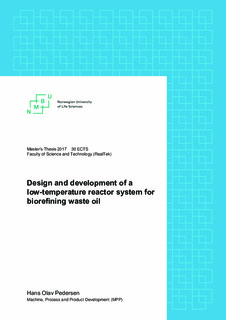| dc.contributor.advisor | Terjesen, Geir | |
| dc.contributor.advisor | Omberg, Kristian | |
| dc.contributor.author | Pedersen, Hans Olav | |
| dc.date.accessioned | 2017-11-09T08:11:10Z | |
| dc.date.available | 2017-11-09T08:11:10Z | |
| dc.date.issued | 2017 | |
| dc.identifier.uri | http://hdl.handle.net/11250/2465087 | |
| dc.description.abstract | The background for this master’s thesis is the focus on bioenergy and biofuels at NMBU. This has, among others, resulted in a prototype of a small-scale biorefinery, which uses methanol and waste cooking oil to produce biodiesel. The purpose of this thesis is to develop a reactor system that serves as a platform for reactors to operate on and a technological alternative for a periodically on-site clean of catalysts. The purpose of the catalysts wash is to extend their lifetime, in order to make the reactor system and thereby the biorefinery more sustainable. The project started with research and literature review in the field of study. Solutions and alternatives were reviewed in an initial design within the concept specifications. Integrated Product Development and SCAMPER is used as methods for the concept development and creating technical alternatives and features. Pugh method has been used for the evaluation and selection of concept. The structure is optimized in a simple FEM structure analysis. Sketches and CAD are used to present the design in 2D and 3D drawings, and an environmental analysis and cost estimate of prototype and series production is completed. The final solution consists of a reactor system with two mounted reactors. Initially, one of them connected to the process of turning the reactants, oil and alcohol, to biodiesel product. The other reactor having its catalyst washed, changed or in other maintenance. When done, the reactor is on stand-by to switch position with the operational one. The position switch happens periodically, by a rotating platform driven and controlled by a motorized rotary stage. Before the rotation, the couplings for the tubes disconnect and when rotated 180 degrees, connects again, this time with the other reactor. Four linear actuators at each inlet and outlet of the reactors, is proposed as a coupling system for disengage and engage motion of the couplings. For further work, it is emphasized to finalize the coupling system, for the reactor system to be completely automatic. As of now the reactor system is depending on manual labor for this job. The structure consists of hollow squared profiles and two decks as housing, mountable with the rest of a biorefinery arrangement. Two types of chemical reactors are presented. Both are continuous packed bed reactors designed for 3D printing, using mainly Polypropylene (PP) as material. The principle is the same for both reactors, using capsules to pack the heterogeneous catalysts for easier reactor and catalyst handling. | nb_NO |
| dc.description.abstract | Bakgrunnen for denne masteroppgaven er fokus på bioenergi og biodrivstoff ved NMBU. Dette har blant annet resultert i en prototype av en små-skala bioraffineri, som bruker metanol og avfalls matolje for å produsere biodiesel. Formålet med denne oppgaven er å utvikle et reaktorsystem, som fungerer som en plattform for reaktorer og med et teknologisk alternativ for en periodisk rengjøring av katalysatorer. Formålet med katalysatorvasken er å forlenge katalysatorens levetid, for å gjøre reaktorsystemet og derved bioraffineriet mer bærekraftig. Prosjektet startet med litteratur gjennomgang av emnet. Innenfor konseptspesifikasjonene ble løsninger og alternativer vurdert som innledende design. Integrert produktutvikling og SCAMPER ble brukt som metoder for konseptutvikling og for å skape tekniske alternativer og funksjoner. Pugh-metoden har blitt brukt til evaluering og valg av konsept. Strukturen er optimalisert i enkle FEM strukturanalyser. Skisser og CAD brukes til å presentere designet i 2D- og 3D-tegninger, og en miljøanalyse og kostnadskalkyle av prototype og serieproduksjon er fullført. Den endelige løsningen består av et reaktorsystem med to monterte reaktorer. En av dem er koblet til prosessen med å omdanne reaktantene, olje og alkohol, til produktet biodiesel. Den andre reaktoren får sin katalysator vasket, byttet ut eller er i annet vedlikehold. Når den er ferdig, står reaktoren i standby, for å bytte posisjon med den biodiesel operative. Posisjonsbyttet skjer periodisk, ved hjelp av en roterende plattform drevet og styrt av et motorisert translasjonsbord. Før rotasjonen, kobles rørene av og når plattformen har dreid 180 grader, kobles på de på igjen, denne gangen med den andre reaktoren. Fire lineære aktuatorer ved hvert innløp og utløp av reaktorene, er foreslått som et koblingssystem for bevegelseskontrollen av koblingene. For videre arbeid legges det vekt på å fullføre koblingssystemet, for at reaktorsystemet skal være helt automatisk. Foreløpig er reaktorsystemet avhengig av manuell arbeidskraft for denne jobben. Strukturen som holder systemet består av kvadrerte hulprofiler og to plater, monterbart med resten av et bioraffineri. To typer kjemiske reaktorer presenteres. Begge er kontinuerlige reaktorer, designet for 3D-print med hovedsakelig polypropylen (PP) som materiale. Prinsippet er likt for begge reaktorene, ved å bruke kapsler for å pakke heterogene katalysatorer, er reaktorene enklere å håndtere når katalysatorene må skiftes ut eller vedlikeholdes. | nb_NO |
| dc.language.iso | eng | nb_NO |
| dc.publisher | Norwegian University of Life Sciences, Ås | nb_NO |
| dc.rights | Attribution-NonCommercial-NoDerivatives 4.0 Internasjonal | * |
| dc.rights.uri | http://creativecommons.org/licenses/by-nc-nd/4.0/deed.no | * |
| dc.subject | Biorefining | nb_NO |
| dc.subject | Bioenergy | nb_NO |
| dc.subject | Chemical reactor | nb_NO |
| dc.subject | Biofuel | nb_NO |
| dc.subject | Biodiesel | nb_NO |
| dc.subject | Heterogeneous catalyst | nb_NO |
| dc.subject | Reactor systems | nb_NO |
| dc.title | Design and development of a low-temperature reactor system for biorefining waste oil | nb_NO |
| dc.type | Master thesis | nb_NO |
| dc.subject.nsi | VDP::Teknologi: 500::Maskinfag: 570 | nb_NO |
| dc.subject.nsi | VDP::Teknologi: 500::Bioteknologi: 590 | nb_NO |
| dc.description.localcode | M-MPP | nb_NO |

